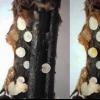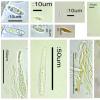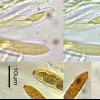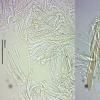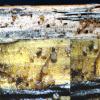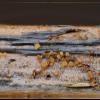
14-01-2026 10:02
Hulda Caroline HolteHello, These ascomycetes were growing on standing

13-01-2026 10:13
 Danny Newman
Danny Newman
Cordieritidaceae sp. on indet. wood w/ Hypoxylon s

13-01-2026 07:57
 Danny Newman
Danny Newman
cf. Bombardia on indet. decorticate woodAppalachia

14-01-2026 07:28
 Danny Newman
Danny Newman
Nemania sp. on indet. decorticate woodAppalachian

12-01-2026 22:02
Ethan CrensonHello all, I am hoping someone will have some ins

11-01-2026 20:35
Hello.A very tiny pyrenomycete sprouting sparsely

13-01-2026 18:55
Rees CronceStrossmayeria sp. on indet. decroticate hardwoodTh

13-01-2026 07:28
 Danny Newman
Danny Newman
Chlorociboria glauca on indet. decorticate logThe

13-01-2026 07:14
 Danny Newman
Danny Newman
Neodasyscypha cerina on indet decorticate logThe S

13-01-2026 09:10
 Danny Newman
Danny Newman
Dasyscyphella chrysotexta on indet. decorticate ha
Ellis and Ellis didn't help me with this so I looked at FRDBI for species associated with Bracken – and was overwhelmed by the list! This pale cream, non-hairy, sessile, cup-cake shaped disco was up to 0.35 mm wide and 0.2 mm high. It was with Rhopograpis filicinum and scattered setae. Spores weren't dropped – or at least weren't obviously shed on the slide overnight, so I resorted to looking for expelled spores or even spores within the asci. Asci were approx 100 x 10, not clearly reacting with Lugol. Paraphyses were thread-like, septate and 2 um wide. In Congo Red (dilute) the spores appeared to be 12-14 x 3-3, and variably septate 1-3. Scanning through Peter Thompson's Ascos in Colour didn't show anything obvious (a pity it doesn't have a substrate index like Ellis and Ellis). Any help much appreciated,
Steve
Just a rough guess - but maybe Allophylaria campanuliformis?
The expected habitat would be on Pteridium or other fern stems from the FRDBI.
Sadly I can't find this species on Zotto's Cubby collection for comparison, but one description is here (as Phialea campanuliformis)
https://archive.org/stream/drlrabenhorstskr0103rabe#page/738/mode/2up
The described ascospores are about 2 microns shorter than yours, the asci 50-60 vs your 100 microns, and there maybe other morphological differences in the text, but it might be worth looking into as a likely candidate.
Hopefully someone with more knowledge than me in this group will chime in!
Cheers,
Brian
Steve
Also - if you want to properly characterise finds like these, and get the best ID, it's worth taking photographs in water first before staining to maximise visualisation of the living characters. A cross-section would help, although it's very tricky with tiny things like these (I slice them on some damp lens tissue with a razor blade under a stereo microscope), or maybe a squash preparation. The ascospores should shoot out eventually if you put a living apothecium in a droplet of water.
You can also add scale bars and measure using ImageJ and the scalebar tools for microscopes (http://www.swarthmore.edu/NatSci/nkaplin1/scalebar.htm), or Richard Shotbolt's MycoCam 4 (http://www.shotbolt.com/shop/shop.htm).
Zotto's images for collections for Allophylaria are here if you want to compare:
https://www.cubbyusercontent.com/pl/CC+Ascomycota/_1354d48ffaad4b59bd3ffdbb35915d1f#CC%20Ascomycota/7a%20Helotiales/Hyaloscyphaceae%20with%20VBs%20(Pezizellaceae)/Allophylaria
Hope some of that helps!
Cheers,
Brian
Cheers,
Steve
It may be worth considering Allophylaria filicum (Species 203 in Ascomycetes in Colour).
Although in the FRDBI this is considered to be a synonym of A. campanuliformis, this is incorrect, as there is, in fact, a significant difference. A. filicum produces a negative reaction to the ascus tip in lugol. A. campanuliformis produces a bright blue reaction.
In Britain, A. filicum is more commonly encountered on ferns, though I do not list bracken among them. There should be signs of the fruit bodies becoming pinkish when damaged.
Incidentally, I have been creating additional species pages for the last year and have so far added 116 species to the 700 in my book. Please advise me if you would like to receive these.
With Best Wishes,
Peter.
Firstly, many thanks for giving us you amazing book on Ascos - it's an invaluable guide to ID for us in our survey of the fungi of the Longshaw estate in Derbyshire.
Secondly, thanks for helping us with the ID of this little Disco on Bracken. Two of us are working on it.
Thirdly, I would be very pleased to receive your updates.
I did find a Disco similar to Allophylaria filicum this spring. It was on dead stems of Hart's Tongue Fern. It was white, but when pricked with a pin it turned yellow and then red, in about 5 mins. I was under the impression that this was Psilachnum chrysostigna var. varicolor.
Best wishes,
Steve

Zotto
Thank you for your reply, and I hope that my book is helpful with your identifications. I always recommend that as many sources of information as possible about ascomycetes are consulted.
One example is that my image of Mollisia cinerea shows mature, young fruit bodies in good condition, whereas in Fungi of Switzerland, volume 1 older fruit bodies which have become lobed and pale grey are illustrated. Both images are equally valid, but very different from each other.
I believe that Psilachnum chrysostigmum var. varicolor is a synonym of P. chrysostigmum, with the latter as the current name. It certainly looks that way in Index/Species Fungorum as well.
Regarding my additional species pages, I should communicate by email, as I can then provide a link to my dropbox. Is your email address shown on Ascofrance the best to use?
With Best Wishes,
Peter.
I'll have another look at the herbarium specimen and chack for colour changes re Lugol, Meltzers etc, also any colour changes to the Disco itself - though I'm aware of the possibility of the dead spores and ascocarps reacting differently to the live ones.
Steve
I think that the value of your book is that it provides a very much-needed catalogue of ascos in colour photos, so you can see what the fungus actually looks like - using key, basic text and diagram such as Ellis and Ellis can be very misleading as I am rapidly finding out. Yes - my email address at AscoFrance is fine. We are finding many, many ascos during our survey of the Longshaw Estate - any additional help such as your updates is much appreciated.
Steve
I have had another look at the Asco on Bracken - here are some more pictures.
Picture 1 - spores and asci:
The spores which I eventually forced out (not ideal I know) were 10-15 x3-4 (in water). They seem to be 1-septate, with rounded ends. Asci are 55-65 x7 (in water).
Picture 2 - Asci tips. In Meltzers there was hardly any reaction - if at all - just the faintest of pale blue (I changed the colour balance a little as my scope is LED and gives a blueish ambience to everything). But in Lugol, everything turned reddish brown, and there was a dark ascus tip reaction. All in all I'd say that there was no bluing of the ascus tip with iodine reagents.
Picture 3 - Squash in water, Meltzers and Lugol - to show the difference.
Picture 4 - Macro photos, showing no colour change in the cut apothecia - but is is a rehydrated specimen. However, I didn't notice colour changes in the fresh sample.
Picture 5 - the best stacked image I can manage until I get a more wobble-free set-up. The apothecia are just over a third of a mm across.
Am I best to leave this as Allophylaria sp?
Many thanks for the help,
Steve
I'd probably go for Allophylaria cf. campanuliformis for now. But if you can, it would be worth checking whether your species is hemiamyloid as Zotto suggested - try diluting the Lugol's solution a little bit, and also try the Lugol reaction after KOH pretreatment.
Have a look at Zotto's page on hemiamyloid reactions here (if you've not seen it already!): http://www.gbif-mycology.de/HostedSites/Baral/IodineReaction.htm
There's been no DNA work on Allophylaria at all, so I have no idea how diverse this group really is or how good the species concepts are. Keep hold of your collection - it might be useful in sorting this out sometime!
Cheers,
Brian
It's amazing how much you learn by looking at stuff like this - I'll look at Zotto's page - I have plenty of ascocarps left to try with Zotto's advice on hemiamyloid reactions. I've only had the decent microscope since January so it's a steep learning curve,
Best regards,
Steve

Chris
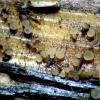
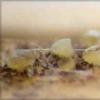
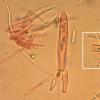
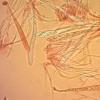
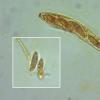
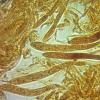
 x-45-a-0001.jpg
x-45-a-0001.jpg